Andrei Rublev, 1966, directed by Andrei Tarkovsky, written by Andrei Tarkovsky and Andrei Konchalovsky.
Here's a minor incident in Andrei Rublev that illustrates the film's moral landscape. A Russian prince is building a new house; he hires stoneworkers to do part of the construction. They finish the work on time and under budget, but the prince isn't happy; he wants the whole place redone because the colors aren't bright enough. The contractors won't do it; they have been hired for another job. As it happens, they're supposed to go work on a house for the prince's brother, where (they unwisely inform the prince), no expense is being spared, and the quality of the stone will be better. The prince shrugs his shoulders, resigns himself to being outshined by his brother, and sends them on their way.
Then he has his soldiers meet them on the road and gouge their eyes out.
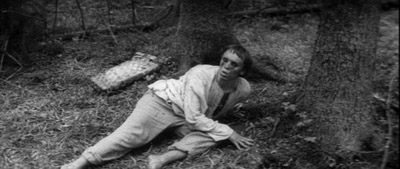
A forest filled with eyeless men screaming in pain and crawling in circles: that's the backdrop of cruelty against which Andrei Rublev operates.
The film is a fictional version of the life of Russia's greatest iconographic painter, and in many ways it's as strange as iconography itself. It's a movie about a great painter in which you never see anyone painting; the title character is usually peripheral to the action (if not entirely absent); it has not three but seven clearly delineated acts (plus a prologue and epilogue), and the first clear footage you see of one of Rublev's paintings occurs roughly three hours and twenty minutes after the film begins. That's right, three hours and twenty minutes (total running time: 205 minutes). So have some coffee ready. The movie deserves both the time and attention it demands, however. Tarkovsky raises questions about power, suffering, theology, and art in a richer fashion than any other filmmaker. I expect to have Andrei Rublev floating around in the back of my mind for a long time.
If you're not familiar with Rublev's work (I wasn't), he lived from around 1360 to 1430. Here's the one surviving painting that's entirely his own, the Old Testament Trinity (the image depicts Abraham's three guests in Genesis 18):
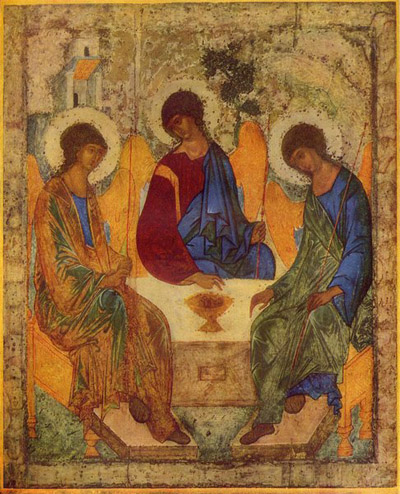
(Click for a high-res version from Wikipedia)
For me, the invention of linear perspective is a bright line between painting I really appreciate and painting that seems more mysterious than approachable. Of course, Eastern iconography isn't meant to be approachable in any sense of the word; part of the point of its strangeness is to remind the viewer that what it depicts is not the world we know, but spiritual truth. In fact, the Eastern Orthodox church had (has?) a set of very strict rules for iconography, established in 1551. The model from which these rules were drawn was the work of one Andrei Rublev. So Rublev's influence was not limited to artists independently imitating and learning from him (as is true of every other artist); his style of painting was church law.
That's all background to the movie, and honestly you don't have to know any of it to appreciate the film. Rublev's personal artistic development is at best a secondary concern; the main concern as I see it is dealing with a world in which the exercise of power, whether by God or man, is unjust and arbitrary. Again and again, Tarkovsky presents the viewer with scenes of people being punished. Sometimes we know why: a jester is arrested for singing an obscene song about a boyar (and dropping his pants). Sometimes, we have no idea: the second act opens with a monk walking across a city square as a man in the background is tied to a rack. He protests his innocence, but we never know what he's innocent of.
Tarkovsky has an eye for the way cruelty and power are exercised. You can see it in the bored faces of the guards in the first act as they smash the jester's face into a tree, or the false bonhomie a Tartar warlord maintains as he marches toward a city he will utterly destroy. Tarkovsky is also keenly aware of the ways the powerless console themselves, from Theophanes the Greek's nihilistic wish for apocalypse ("We'll burn like candles") to Rublev's withdrawal into asceticism. But then, growing up under Stalin would give anyone an unusually strong grasp of the way the powerful use cruelty, terror, and pain.
For me, at least, it was impossible to watch this movie without thinking of Stalin. Tarkovsky was born in 1932; for the first twenty years of his life, he knew no other political leader. Martin Amis has written that Stalin's cruelty "was not medieval so much as ancient in its severity." Well, Andrei Rublev has plenty of medievally severe cruelty. Some of it is difficult to watch. And in the Russia that Tarkovsky grew up in, medievally severe cruelty simply wasn't severe enough. Medieval severity just wouldn't do. It should be no wonder that what could have been a traditional biopic became a meditation on the artist's role in an unjust society.
All this makes the movie sound at once more cruel and faster paced than it really is. Art is part of Rublev's story, and it's not entirely a story of suffering. You can see Rublev struggle from beginning to end with a question which must have had personal significance for Tarkovsky: does an artist have a responsibility to the powerless? In the first act, Rublev says nothing as the jester is taken away; in the third, he stumbles onto a pagan celebration and later says nothing as soldiers round up the revelers. He is hired by the same prince that gouges his coworker's eyes out, and again does nothing. When he finally does act, killing a Tartar during the sack of Vladimir, he is wracked with guilt and retreats entirely from the world, ceasing his painting and taking a vow of silence which he does not break for years. The question of when artists should bear witness, when they should intervene, and when they must forgive hangs over Rublev's life from beginning to end. It's not a great stretch of the imagination to imagine that it also hung over Tarkovsky's.
The cinematography in this film is spectacular. Tarkovsky and his D.P. Vadim Yusov have a genius for camera movement, and there are shots in this film that rival Scorcese or Welles at their most elaborate. The best example of this is a shot toward the end, during a sequence in which a cathedral bell is about to be raised from the hole in which it has just been cast. This is one continuous shot, broken down into frames, and worth going over in its entirety.
The camera begins rougly above the bell, looking at the line of cables that will be used to pull it from its hole:

The camera follows the cables up, revealing the walls of a city in the distance and putting a procession on horseback crossing a bridge toward the center (this is the prince who has commissioned the bell, leading an Italian ambassador up to hear the bell ring for the first time, but we don't know this yet):

We follow their path across the bridge and up into the middle distance:

The structure of a building appears in the left part of the frame and the camera leaves the procession to track along the roofbeams...:
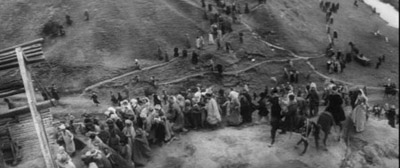
...Revealing that the building is, in fact, the forge where the metal for the bell was fired (we've seen it in an earlier scene).
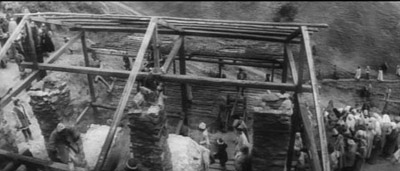
Tracking the beams all the way across reveals a group of men gathered around a winch further left:
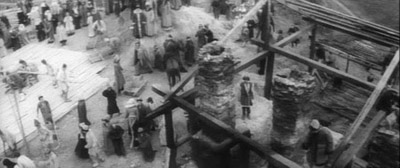
The camera centers on the winch...

...and then begins a vertical pan along the rope they are pulling, until a man's head appears very near the foreground:
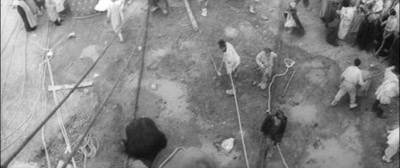
He's standing on a wooden structure directly below the camera; one of its beams cuts straight across the frame as we track back:

Until we are looking down into the pit the frame encloses, and can see the bell far below us, with all the ropes attached.
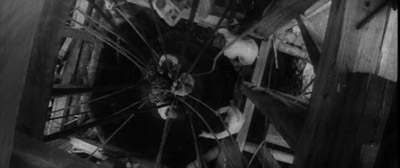
I love two things about this shot;. First, its scale varies incredibly rapidly. The city walls must be a mile away; the man on the bell structure is a few feet from the lens. You can see kind of the same thing in some of Peter Jackson's best work on Lord of the Rings. The other thing about this sequence is that the camera's movement seems to be motivated more by geometry than by anything human. If you look at the Copacabana shot in Goodfellas, part of what makes it so inviting is the way the camera tails Ray Liotta, like you're someone who also gets to go into the back entrance to the Copa (the same holds for all the shots that ripped it off after then). This is different; the camera seems to pick up a geometric shape in the image (the lines of the cables, or the roofbeams, or the bridge) and tracks it until a more interesting line to follow appears. It's spectacular but not intimate, not human. Tarkovsky's detatchment here reminds me of nothing so much as iconography.
Randoms:
- The eye-gouging is by no means the hardest thing to watch in this movie. The sack of Vladimir in the second part is nearly impossible to watch. It seems to be based at least in part on Guernica, and has many shots that are truly horrifying (a cow smashing around a stable in terror, its skin on fire; a horse falling down a flight of stairs, struggling to its feet, and collapsing backwards as its broken legs convulse; blood jetting from a young boy's neck). It ends with a villager (a priest?) being tortured to death inside a church. He asks to be allowed to kiss a cross before dying; his tormentors agree, then melt a silver cross down, hold his mouth open, and pour several cups of molten metal down his throat. The gurgling sound he makes has already appeared in one of my nightmares.
- Vlada Petric quotes Tarkovsky in one of the extra features as saying that what makes a film epic is when each character is his own center of the movie. I think this is a valuable point. When I'm working on an outline for a screenplay, I know I'm on the right track when I can tell the story from the perspective of any of the main characters and get a coherent movie with a beginning, middle, and end. Andrei Rublev takes this to a real extreme; Rublev is arguably not the main character in almost every act of the movie. But from the perspective of any character the film stays with during an act, there's a real story, beginning, middle, and end.
- I went all the way through that one shot of the bell and I didn't even mention what was, for me, the most beautiful sequence in the movie: Andrei Rublev's vision of the crucifixion. It's pretty traditional, with one exception. It's in Russia in the middle of winter. One still from this hauntingly beautiful scene:
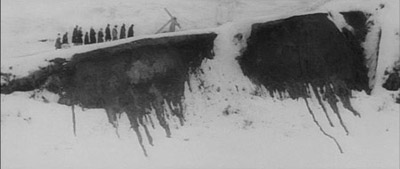
- The release history of this film is troubled; for some reason, the Soviets didn't want something that could be read as critical of the Soviet experiment on the market. For an example of why they didn't like it, try to read this description of the Pharisees (from the voiceover to the crucifixion scene) and not think of the Russian Revolution:
The Pharisees were masters of deceit, educated. They had studied to gain power, to take advantage of the people's ignorance. We must remind people more often that they are people. Russians, of the same blood, of the same land.
As a result of passages like these, the film was shelved upon its completion in 1966 and not publically shown until the 1969 Cannes Film Festival (when it was shown semi-illegally, over protests from the Soviet Embassy). This gap between completion and screening is why the IMDB lists the film as being from 1969, the Criterion Collection from 1966.


18 comments:
Hey man, I really appreciate your feedback & I'm glad you're enjoying this. I read your first two posts and I think yours is going to be great. I'd like to link to you but I'm having trouble figuring out how to put a blogroll in the template. So if you want to show me how (which would be much appreciated), you can reach me at mdessem at gmail dot com. Incidentally, I'm envious that you guys got 2046 before the U.S.--this weekend is my first chance to see it.
Matthew,
This blog is so interesting and enjoyable. Good work. You could turn this into one hell of a book when you're finished. Next blog: the Janus Collection.
Cheers
WW
WW,
Thanks for the kind words. At my current rate I'll be done long after DVDs have become completely obsolete. Re: a book, the problem (probably insurmountable) would be clearing the rights for film stills.
Matt
This is a beautiful essay; it makes me want to see the film again. I've watched it half a dozen times, but not in three or four years. One minor thought, based on a hazy memory: I thought Andrei's version of the crucifixion was supposed to be heretical--because it excludes the element of evil? Something like that...
Anyway, I look forward to reading your other essays!
Ben F
Ben,
Thanks -- I'm glad you enjoyed the essay. I'm not certain about Rublev's crucifixion; I've gotta see it again.
Those black spots on the hill in this scene:
http://farm3.static.flickr.com/2128/2214104570_71ccd4c7ba_o.jpg
Those are way to close to the empty eye sockets of the stoneworkers to be a coincidence.
Greg,
Good eye! Or sockets, as the case may be.
Hi Matthew,
I'd just like to add my appreciation for your work - this looks like a huge project! I've begun by reading only your reviews of those Criterions which I own myself (we can't rent them over here in the UK, more's the pity) and I'm very impressed so far - particularly with this review of Andrei Rublev. I think my lunchtime reading for the next few weeks is right here. Keep up the good work!
Noel
I'm glad you liked Andrei Rublev so much. For me, Tarkovsky, along with Bergman and some of the Japanese directors from around this time, is simply unparalleled. I've seen all of his movies except for Mirror and Nostalgia, and while I could take or leave Solaris, you have to be sure to watch Stalker and the Sacrifice. If you liked the cinematography in Rublev, you'll be blown away by Stalker; it's quite obvious that Tarkovsky took over this role himself for this movie. Also be sure to check out Bergman's Persona, even though it's not Criterion. That, along with Winter Light, Scenes from a Marriage, and Fanny and Alexander (5 hr version) will simply astound you.
“I once heard Samuel Delany explain that for each reader, there are two different kinds of writers. The first is immediately accessible, speaking our (psychological) tongue, the voice of home, familiar and revered. The second speaks an alien tongue, words which mystify as much as they enlighten, creating an initial reading experience of gaps and silence as the night sky against which bolts of excitement and partial comprehension flare like lightning. The first kind of writer offers us comfort and harmony, the pleasure of hearing our own beliefs stated with that artistry and grace we achieve only in our dreams; the second offers the thornier and more intellectual pleasure of learning a new tongue, of contemplating and grappling with ideas that our own experience could never conceive.” –Kathleen L. Spencer, “Neveryon Deconstructed”
Change a word here and there, and the above can be said about film, and Andrei Tarkovsky with Andrei Rublev is very much the second kind of filmmaker. The narrative and structure may be obtuse, but the confusion is not due to ineptitude. You sense early on that you are in the hands of a master who is inviting you to contemplate his film, and it’s not meant to be an easy ride. (Although to craft a film requiring multiple viewings to arrive at anything more than a cursory understanding twenty years before the widespread availability of video does strike me as somewhat self-indulgent. His Sculpting In Time, while valuable reading, occasionally crosses the line into sanctimony.) That being said, if it is your aim to provide your audience with a puzzle that only repeated viewings can solve, you do have to give them a reason to keep coming back.
What Tarkovsky gives us in Andrei Rublev is breathtaking cinematography. I don’t think I’ve ever seen a film where I was so aware of texture. The deep focus forces you to pay equal attention to foreground, mid-field and the action occurring in the far distance. And while montage is impressive in a flashy sort of way, I’ve come to appreciate far more the quiet virtuosity, technical achievement, and precise choreography of the protracted take.
“So far [said Pryn], this story sounds more confusing than exciting.”
“To the proper hearer,” said Norema, “precisely what seems confusing will be the exciting part.” –Samuel R. Delany, Neveryona
shame on me for not saying anything about this film until now ... better later than never =]
one thing i want to add is a nice complement to andrei rublev that covers similar themes (faith + art/imagination in the face of great adversity) that only takes up about thirty-five or so percent of the time and it isn't as intense ... the secret of kells. the animation is gorgeous and was nominated for an academy award for best animated feature in 2009 (lost to up).
personally it's one of my favourite films and an example of how cinema can provide transcendence and apotheosis. i look at it as one of my own creative manifestos where the reward for struggling for your art is a means for others to be elevated from the world of darkness into the world of light.
and yes, i eagerly await the upgrade =]
oh one more thing ... i actually like its working title more: strasti po andrei or "the passion according to andrei" ... for it has a three-fold meaning:
1) this is andrei rublev's own struggle, felt both personally and at large
2) his struggle is an off-shoot of sorts with *the* passion ... and of course it's discussed and depicted in the film
3) it's a metaphorical parallel for its auteur and thus can also be understood as "the passion according to andrei *tarkovsky*"
=D
John,
I love the quotes in your comment; the second kind of writer is my favorite. (Although a mediocre example of the first kind of writer is much better than a mediocre example of the second kind...)
DJ Project,
Secret of Kells is in my queue, thanks for the recommendation!
Matthew,
You have a splendid, epic little blog here. I find it filled with huge insight into the tiniest of details.
I look forward to reading your essays as much as viewing the official supplements themselves, which is to say both help enhance my appreciation and understanding of whatever film happens to demand a closer inspection, i.e., all of them.
Keep up the inspired commentary.
Best,
Charles
Tarkovsky was a master of his art and no one could equal him in what he did. He could make cinema attain new heights and depths. A magnificent film that is undoubtedly one of the best arthouse production of all time.
Please do take sometime out to read my review of the movie:
http://www.apotpourriofvestiges.com/2012/05/andrei-rublev-1966-russian-auteur.html
I can't wait until you reach #164, Tarkovsky's Solaris.
Really nice post! Lots of great background info. and observations.
I was particularly struck by your comments on how the camera follows one line, and then "a more interesting line" in the final scene(s) of the cathedral bell.
In many parts of the movie, I felt the camera's gaze to be indifferent, inhuman (as you say), even alien. It makes me shudder to think whose gaze it might represent.
Post a Comment